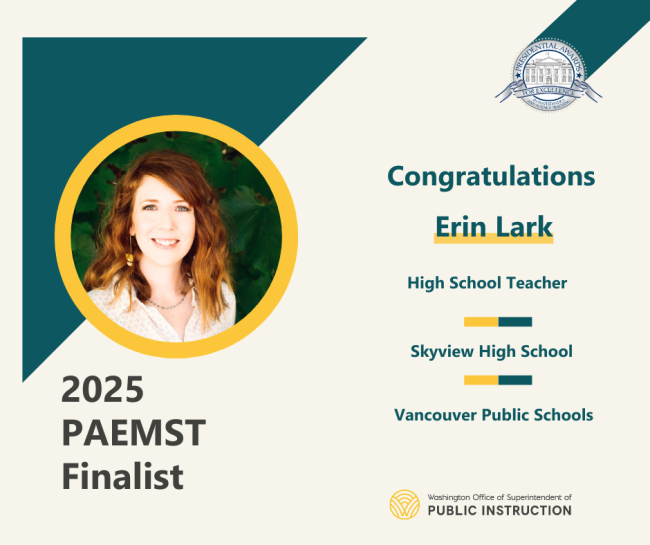Erin Lark
Media Contact
Katy Payne she/her
360-764-0201

What has been your personal journey on the way to excellence in teaching math/science?
Two shifts transformed my teaching over time. First, I moved from delivering content to cultivating curiosity. I encourage questions over answers, process over perfection. My classroom is a space of creativity and critical thinking, where challenges are an expectation, failure is a stepping stone, and relevance is at the heart of our work. Second, I teach civic engagement in science class. It's not enough for students to learn about their world, they need to learn what they can do next. Armed with science concepts, skills, and processes, students can advocate for a future they want, whether their career path is within science or beyond. Because that's the magic of science learning—it's not just about life as it is, but the world student can help build.
What is one concept that excites your students and why?
One concept that truly excites my biology students is CRISPR and gene editing. It's not just cutting-edge science—it feels like something out of science fiction—only it's real. When students learn that we can potentially cure genetic diseases, engineer disease-resistant crops, or even bring back extinct species like the return of dire wolves, their curiosity lights up. It shifts biology from something you study to something you use. Most of all, CRISPR gives students a sense of agency. They see biology not just as facts in a textbook, but as a powerful tool that could solve real problems. It makes them ask: "What role could I play in this future?" And that's when the real learning begins.
How do your lesson planning and teaching practices engage and support all students?
Crafting a unit is like baking a cake. For the layers, I'm all about hands-on, inquiry-driven learning. Students experiment, explore, and ask their own questions. Whether designing a model, diving into a virtual lab, or analyzing real data, I want them to do science. I use a mix of strategies to meet students where they are—group work, tech tools, language-centered tasks—and offer flexible ways to show what they know. Regular check-ins help me adjust and support with a little extra or a different approach. My favorite way to frost the cake is to level up on relevance. Whether checking TikTok, CNN, or asking directly, I look for content that has students buzzing. I teach science standards through the lens of what students care about now—be it social justice, short-form videos, or both. More than anything, I try to create a space where students feel safe to take risks, be curious, and grow.
How do the math and science concepts and skills you are teaching students help to prepare them for later learning, careers, and life?
I focus on helping students build the skills they need for future careers and to make a real impact. In class, we practice critical thinking, problem-solving, and teamwork—skills essential for careers in fields such as tech, healthcare, and engineering, as well as for tackling everyday challenges with authenticity. Students might design their own renewable energy solutions, use data to understand climate change, or investigate how tech impacts our daily lives. Projects like analyzing local water quality and presenting solutions to the community or collaborating on how to reduce waste in their school give students experience in a trajectory of positive impact. They learn how science influences public policy, from environmental laws to healthcare decisions, and how they can contribute in ways that will mold their future. By blending science with civic engagement, students not only learn core concepts through doing science—they become informed, active citizens who can speak up, solve problems, and drive the change they want for their future.
What can math and science teachers do to make those disciplines more culturally sustaining for students with diverse identities and experiences?
As educators, our goal isn't just to teach content, but to make math and science relevant and meaningful for every student in our classrooms. To do that, we need to ensure all students see themselves in the work we do together. Teachers can highlight pioneers in the fields of math and science that represent their students and highlight contributions of students' heroes. We can also connect our content to students' communities, whether through discussing local environmental issues in ecology or using math to explore real-world topics like healthcare, we make the subjects feel relevant to students' lives. Using relevant teaching methods is key, whether including new approaches to math or examining indigenous knowledge in science, we must value student experiences, interests, and values.
What advice would you give to parents, families, or caregivers who want to support their students’ math and science learning?
You don't need to be an expert—you just need to nurture their learning. Start by encouraging questions. Next, promote a growth mindset. Remind your child that it's okay to struggle, mistakes are part of learning. Praise effort and persistence, not just correct answers. Create hands-on learning opportunities: cook together and talk about measurements, play math games, or bring them in to help as you solve problems around your home. Stay engaged by asking about what they're learning in school, attend community events that celebrate or showcase STEM, and stay connected with teachers. Finally, make real-life connections. Talk about how math and science show up in everyday life—weather, technology, nature, or even your job. When students see that their families value these subjects, it boosts their confidence and motivation. With your support, our future leaders will stay curious and change the world.






